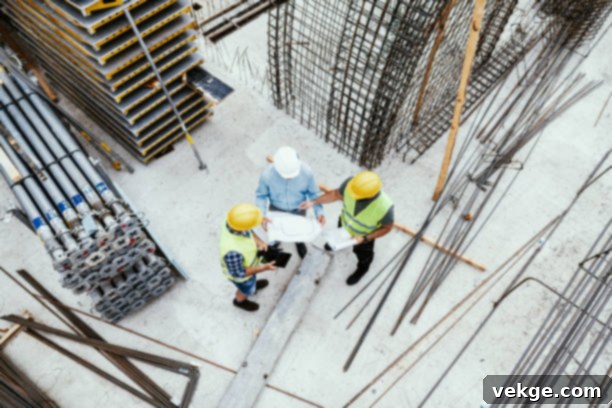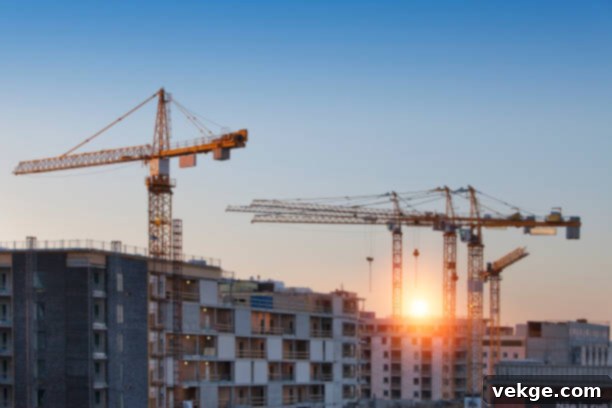Investing in Excellence: Why Quality Construction Materials Deliver Long-Term Value and Superior Performance
At the core of every successful and resilient construction project lies the unwavering commitment to quality materials. While the initial investment in premium construction supplies might seem higher, this decision consistently yields superior results, significant long-term savings, and ultimately, greater peace of mind. Choosing quality isn’t merely about aesthetics or brand prestige; it’s a fundamental, practical choice that profoundly impacts structural integrity, ongoing maintenance demands, and the entire lifespan of your build. Understanding the true lifecycle cost of materials is crucial for any developer, builder, or homeowner looking to create durable, safe, and efficient structures.
The Hidden Costs of Opting for Low-Quality Materials
The allure of upfront savings can often overshadow the substantial long-term financial and operational burdens associated with inferior construction materials. What appears to be a cost-effective choice in the short term frequently escalates into significant expenses, delays, and frustrations down the line.
Short-Term Savings Versus Long-Term Liabilities
Consider a common scenario: a lower-grade waterproofing membrane might offer an initial saving of a few hundred dollars. However, if this cheaper alternative fails prematurely after just three to five years, rather than its expected fifteen to twenty, the repercussions are far more severe than just the replacement cost of the membrane itself. You’ll be facing extensive expenses for repairing water damage to internal structural elements, electrical systems, intricate insulation, and costly finished surfaces. These repairs often involve invasive demolition, lengthy remediation processes, and substantial labor costs, far outweighing the initial savings. Similarly, cheap exterior paints might save on material costs, but their shorter lifespan means more frequent repainting, doubling or tripling labor and material costs over the building’s life.
The Ripple Effect: Compromising Integrated Systems
Modern construction projects are intricate ecosystems where every component interacts and relies on others. When one element falters due to poor quality, it doesn’t just fail in isolation; it often initiates a detrimental chain reaction, compromising adjacent systems and materials, leading to a domino effect of escalating problems and expenses.
For instance, a recent commercial project in Sydney experienced significant structural issues due to the use of inferior concrete additives. These additives initially led to minor surface crazing and micro-cracking. Over time, these seemingly insignificant flaws allowed moisture to penetrate the concrete matrix, reaching and compromising the embedded steel reinforcement. This resulted in concrete spalling – where sections of concrete break off – and severe structural concerns that demanded extensive, costly remediation. What began as a minor budget saving on concrete admixtures ultimately led to repair costs exceeding $75,000, along with a three-month delay in occupancy, causing significant financial losses and reputational damage. Similar issues can arise with low-grade fasteners or connectors that corrode prematurely, leading to cladding failures or weakened structural connections, posing significant safety hazards and requiring emergency repairs.

Key Benefits of Utilizing Premium Construction Materials
The advantages of choosing premium construction materials extend far beyond mere compliance; they are foundational to creating resilient, safe, and sustainable buildings that stand the test of time and outperform expectations.
Superior Durability and Enhanced Longevity
Quality materials are meticulously engineered and manufactured to retain their intended properties and performance characteristics over extended periods. For instance, premium concrete admixtures are designed not only to achieve optimal compressive strength but also to resist degradation from relentless environmental factors. These include intense UV exposure, corrosive chemical attacks from soil minerals or industrial cleaning agents, and the destructive effects of repeated freeze-thaw cycles. The scientific rigor behind this superior durability often hinges on the purity of raw ingredients, advanced manufacturing precision, and stringent quality control processes.
For example, high-quality concrete waterproofing admixtures contain precisely formulated chemical compounds that react completely and homogeneously throughout the concrete matrix, forming a dense, impermeable barrier. In contrast, cheaper alternatives often contain inert fillers that do not fully react, creating microscopic pathways and voids for moisture ingress over time, ultimately compromising the material’s integrity and leading to failures.
Enhanced Performance Under Diverse and Extreme Conditions
Australia’s incredibly diverse and often harsh climate presents unique and formidable challenges for building materials. From the high tropical humidity of Queensland to Melbourne’s notorious “four seasons in one day” temperature swings, and Perth’s intense UV radiation, construction materials must be robust enough to withstand significant and varied environmental stresses. Premium materials are specifically designed and rigorously tested with these demanding conditions in mind.
High-performance sealants, for example, maintain their flexibility and adhesive properties despite years of extreme heat cycling and structural movement. Quality roofing membranes resist severe UV degradation, hail impact, and wind uplift, preserving the building envelope. Furthermore, properly formulated concrete can withstand sulphate attacks from aggressive soil conditions, preventing premature deterioration. This inherent resilience directly translates into fewer maintenance issues, lower repair costs, and a significantly longer service life for the entire structure, enhancing its total cost of ownership.
Improved Safety Standards and Regulatory Compliance
Beyond their impressive durability and performance metrics, premium construction materials inherently offer enhanced safety characteristics. They are far more likely to be independently tested, certified as non-toxic, possess superior fire-resistant properties, and rigorously meet or exceed stringent Australian building standards, rather than merely claiming compliance. This provides a critical layer of assurance for all stakeholders.
For homeowners and occupants, this means a significantly reduced risk of material-related hazards, such as harmful VOC (Volatile Organic Compound) off-gassing from adhesives or paints, the rapid spread of fire, or catastrophic structural failure due to substandard components. For builders and contractors, it instills greater confidence in meeting complex regulatory requirements, minimizing potential liability issues, and safeguarding their professional reputation. Moreover, comprehensive technical documentation and transparent testing data from reputable manufacturers simplify the process of compliance verification during crucial building inspections, ensuring a smoother project lifecycle.
Smart Material Selection for Critical Applications
Certain components within a building are unequivocally vital for its long-term health, safety, and performance. In these critical areas, the choice of material is not just important, but absolutely paramount.
Waterproofing and Effective Moisture Control
Water damage remains one of the most pervasive and expensive building defects in Australia, accounting for billions of dollars in remediation costs annually. Effective moisture control is not a single product solution but requires a comprehensive systems approach, deploying quality materials at every potential vulnerability point in the building envelope.
Particularly critical are the expansion and contraction points within concrete structures, where building movement naturally occurs. Premium expansion foam provides essential protection at these junctures. It effectively accommodates thermal expansion and contraction, seismic activity, and other structural movements, while simultaneously maintaining watertight seals. Unlike inferior alternatives that may permanently compress, degrade rapidly when exposed to moisture, or lose their elasticity, quality expansion foam retains its resilience and performs reliably for decades. This single, often overlooked component plays an absolutely crucial role in preventing water ingress, which could otherwise lead to severe issues like concrete cancer, hazardous mould growth, and extensive interior damage, including to finishes, flooring, and electrical systems.
Ensuring Structural Integrity with Quality Components
Building elements that directly influence structural performance and stability cannot be compromised without risking the fundamental safety and longevity of the entire structure. This critical category includes foundation components, structural connection systems (like bolts, welds, and anchors), load-bearing materials (such as structural steel or reinforced concrete), and all reinforcement products. The integrity of these components is non-negotiable.
Quality materials in these applications offer independently certified performance characteristics, are produced under consistent and rigorous manufacturing standards, and come with full traceability. For instance, premium concrete additives deliver predictable strength development, optimal workability, and enhanced durability – characteristics that directly influence a structure’s load-bearing capacity and its designed service life. The subtle differences between mid-grade and premium-grade materials, while perhaps not immediately apparent on day one of construction, become critically evident and increasingly pronounced over decades of service, often dictating the longevity and safety profile of the entire edifice.
Expert Tips for Identifying Quality Construction Materials
Making informed material choices requires diligence and an understanding of what distinguishes truly reliable products from their lesser counterparts. Don’t just rely on marketing claims; dig deeper to ensure you’re getting what you pay for.
Key Certifications and Standards to Look For
Australia boasts robust building material standards designed to ensure safety and performance. However, not all products on the market meet these benchmarks equally, and some may only offer minimal compliance. When sourcing materials, always look for concrete evidence of:
- CodeMark Certification: Essential for innovative building products, providing an alternative solution to traditional compliance pathways under the National Construction Code (NCC).
- Australian Standard (AS/NZS) Compliance Documentation: Verifiable proof that the product conforms to relevant Australian and New Zealand Standards, covering aspects like strength, durability, and safety.
- Independent Third-Party Testing Results: Demand reports from accredited laboratories, not just manufacturer’s internal claims. These provide unbiased validation of performance.
- Environmental Product Declarations (EPDs): Increasingly important for sustainable building, EPDs transparently communicate the environmental impact of a product throughout its lifecycle.
- Specific Performance Metrics: Look for quantifiable data (e.g., compressive strength, fire rating, R-value, UV resistance, tensile strength) rather than vague or generic quality claims.
- ISO Certifications (e.g., ISO 9001 for Quality Management): Indicates a manufacturer’s commitment to consistent quality processes.
Materials that meet these rigorous standards typically undergo extensive testing for strength, durability, environmental impacts, and precise chemical composition. This provides invaluable assurance that they will perform exactly as expected under the demanding conditions of a real-world construction environment.
Essential Questions to Ask Your Supplier
A truly reputable and trustworthy supplier will not only welcome detailed questions about their products but will also be proactive in providing comprehensive answers and supporting documentation. When engaging with suppliers, consider asking the following critical questions:
- Can you provide comprehensive test reports from independent, accredited laboratories specific to this product?
- Which specific Australian Standards (AS/NZS) and sections of the National Construction Code (NCC) does this product explicitly meet or exceed?
- Is this particular grade or formulation of the material the most appropriate for my specific application and the environmental conditions of my project?
- What is the manufacturer’s expected service life of this product under typical operational conditions, and what is the warranty period?
- Do you offer technical support, installation guidelines, or troubleshooting assistance for this product?
- Can you provide Safety Data Sheets (SDS) and Technical Data Sheets (TDS)?
- What are the lead times for this material, and what is your return or replacement policy in case of defects?
Be extremely wary of suppliers who are hesitant to provide detailed specifications, cannot offer supporting documentation, or whose primary selling point is solely based on price advantages without adequately addressing performance characteristics, long-term durability, or compliance. The best suppliers act as knowledgeable consultants, actively helping you select the most appropriate materials based on your unique project requirements and long-term goals, rather than simply moving products.
The True Value Proposition of Quality Construction Materials
Ultimately, quality construction materials should not be viewed merely as a cost, but rather as a strategic investment – an investment in unparalleled performance, enduring durability, enhanced safety, and ultimately, invaluable peace of mind. While budget constraints are undeniably real considerations for any construction project, a holistic understanding of the full lifecycle implications of material choices helps to place initial pricing into its proper and much broader perspective.
The true value of specifying and utilizing premium materials lies not just in proactively avoiding costly problems, unexpected repairs, and frustrating delays, but in consistently creating structures that perform optimally, efficiently, and safely throughout their entire intended service life. For homeowners, this translates directly into significantly fewer maintenance headaches, lower lifetime ownership costs, and a higher resale value for their property. For builders, developers, and contractors, it means an enhanced reputation within the industry, drastically reduced callbacks, minimized liability risks, and the deep professional satisfaction of delivering quality that not only meets but genuinely stands the test of time, weathering challenges for generations to come. Make the wise choice; invest in quality, invest in the future.
